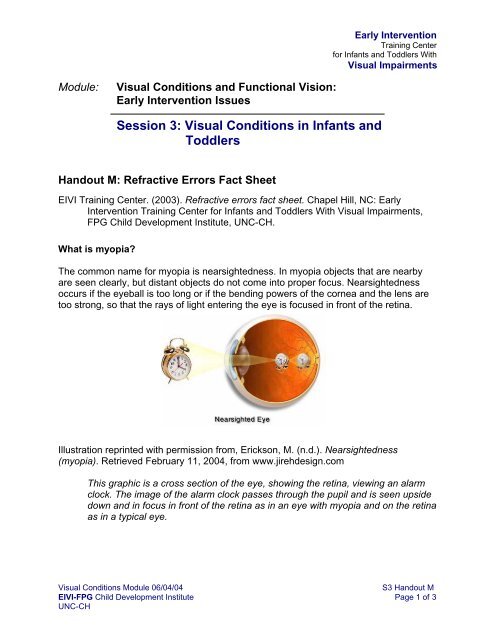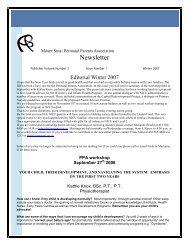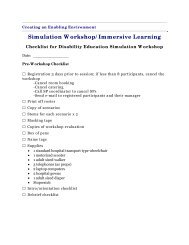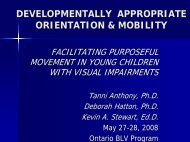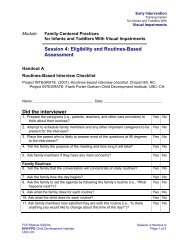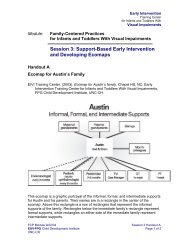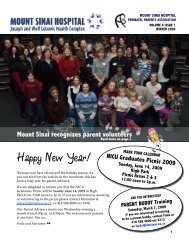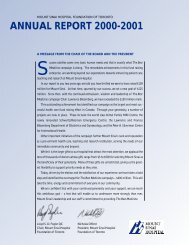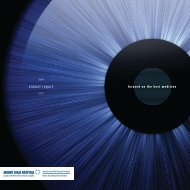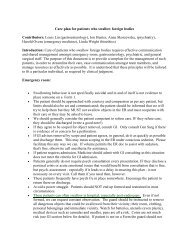Refractive Errors Fact Sheet - Mount Sinai Hospital
Refractive Errors Fact Sheet - Mount Sinai Hospital
Refractive Errors Fact Sheet - Mount Sinai Hospital
You also want an ePaper? Increase the reach of your titles
YUMPU automatically turns print PDFs into web optimized ePapers that Google loves.
Early Intervention<br />
Training Center<br />
for Infants and Toddlers With<br />
Visual Impairments<br />
Module:<br />
Visual Conditions and Functional Vision:<br />
Early Intervention Issues<br />
Session 3: Visual Conditions in Infants and<br />
Toddlers<br />
Handout M: <strong>Refractive</strong> <strong>Errors</strong> <strong>Fact</strong> <strong>Sheet</strong><br />
EIVI Training Center. (2003). <strong>Refractive</strong> errors fact sheet. Chapel Hill, NC: Early<br />
Intervention Training Center for Infants and Toddlers With Visual Impairments,<br />
FPG Child Development Institute, UNC-CH.<br />
What is myopia?<br />
The common name for myopia is nearsightedness. In myopia objects that are nearby<br />
are seen clearly, but distant objects do not come into proper focus. Nearsightedness<br />
occurs if the eyeball is too long or if the bending powers of the cornea and the lens are<br />
too strong, so that the rays of light entering the eye is focused in front of the retina.<br />
Illustration reprinted with permission from, Erickson, M. (n.d.). Nearsightedness<br />
(myopia). Retrieved February 11, 2004, from www.jirehdesign.com<br />
This graphic is a cross section of the eye, showing the retina, viewing an alarm<br />
clock. The image of the alarm clock passes through the pupil and is seen upside<br />
down and in focus in front of the retina as in an eye with myopia and on the retina<br />
as in a typical eye.<br />
Visual Conditions Module 06/04/04<br />
S3 Handout M<br />
EIVI-FPG Child Development Institute Page 1 of 3<br />
UNC-CH
Early Intervention<br />
Training Center<br />
for Infants and Toddlers With<br />
Visual Impairments<br />
The normal eye is about 24mm in diameter. In cases of severe myopia, the eye<br />
gradually enlarges in the front and rear and can reach about 30 mm in diameter. In<br />
those cases the retina and choroids are also stretched, causing their function to<br />
decrease. These eyes do not have good visual acuity even when the focus is properly<br />
centered on the retina. Finally, the retina and choroids may become very thin, leading to<br />
retinal detachment that results in visual loss if left untreated.<br />
Signs and symptoms of myopia<br />
The most common sign of nearsightedness is difficulty seeing distant objects. Objects<br />
appear fuzzy, depending on distance. In young children signs of myopia may include<br />
behaviors such as ignoring objects in the distance, frowning, squinting, and frequent<br />
headaches.<br />
Treatment of myopia<br />
An examination by an eye care specialist includes testing for nearsightedness.<br />
Optometrists or ophthalmologists can prescribe eyeglasses or contact lenses to<br />
optically correct nearsightedness by altering the way that light enters the eyes.<br />
What is hyperopia?<br />
Hyperopia, or farsightedness, occurs when light entering the eye is focused behind the<br />
retina, instead of directly on it. Hyperopia results from a shorter than normal eyeball or<br />
from the reduced bending power of the cornea or the lens. Children with hyperopia<br />
usually have trouble seeing up close but may have difficulty seeing far away as well.<br />
People are generally born with a small amount of hyperopia, but as the eye grows this<br />
decreases.<br />
Illustration reprinted with permission from, Erickson, M. (n.d.). Farsightedness<br />
(hyperopia). Retrieved February 11, 2004, from www.jirehdesign.com<br />
This graphic is a cross section of the eye, showing the retina, viewing an alarm<br />
clock. The image of the alarm clock passes through the pupil and is seen upside<br />
down and in focus behind the retina as in an eye with hyperopia and on the retina<br />
as in a typical eye.<br />
Visual Conditions Module 06/04/04<br />
S3 Handout M<br />
EIVI-FPG Child Development Institute Page 2 of 3<br />
UNC-CH
Early Intervention<br />
Training Center<br />
for Infants and Toddlers With<br />
Visual Impairments<br />
Signs and symptoms of hyperopia<br />
Children who are hyperopic have difficulty seeing up close and, depending on the<br />
severity of the condition, may have blurred distance vision. Hyperopia may also cause<br />
eye fatigue and strain resulting in headaches, a pulling sensation, or burning of the eye.<br />
Young children with hyperopia may also have crossed eyes or strabismus.<br />
Treatment of hyperopia<br />
Hyperopia is detected with a vision test called refraction. Young children’s eyes are<br />
dilated for this test so they are unable to mask their farsightedness with<br />
accommodation. The treatment for hyperopia depends on the child’s age and activity<br />
level. Young children may or may not require glasses or contact lenses, depending on<br />
their ability to compensate for their farsightedness with accommodation.<br />
References<br />
Wright, K.W. (2003). <strong>Refractive</strong> errors and spectacles in children. In K.W. Wright (Ed.),<br />
Pediatric ophthalmology for primary care (2nd ed., pp. 71-76). Los Angeles:<br />
American Academy of Pediatrics.<br />
Visual Conditions Module 06/04/04<br />
S3 Handout M<br />
EIVI-FPG Child Development Institute Page 3 of 3<br />
UNC-CH


